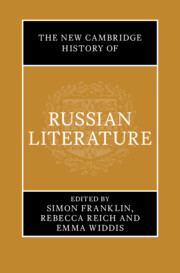Book contents
- The New Cambridge History of Russian Literature
- The New Cambridge History of Russian Literature
- Copyright page
- Contents
- Figures
- Contributors
- Acknowledgements
- On Transliteration, Names, and Dates
- Introduction
- History 1 Movements
- History 2 Mechanisms
- 2.1 The Monastery
- 2.2 The Court
- 2.3 The Salon and the Circle
- 2.4 The Thick Journal
- 2.5 The Publisher
- 2.6 Queerness
- 2.7 The Censor
- 2.8 The Voice
- 2.9 The Self-Publisher
- 2.10 The Market
- 2.11 The Internet
- 2.12 Empire
- Boxes 3 Places
- Boxes 4 Narrative Voices
- History 3 Forms
- History 4 Heroes
- Index
- References
2.3 - The Salon and the Circle
from History 2 - Mechanisms
Published online by Cambridge University Press: 31 December 2024
- The New Cambridge History of Russian Literature
- The New Cambridge History of Russian Literature
- Copyright page
- Contents
- Figures
- Contributors
- Acknowledgements
- On Transliteration, Names, and Dates
- Introduction
- History 1 Movements
- History 2 Mechanisms
- 2.1 The Monastery
- 2.2 The Court
- 2.3 The Salon and the Circle
- 2.4 The Thick Journal
- 2.5 The Publisher
- 2.6 Queerness
- 2.7 The Censor
- 2.8 The Voice
- 2.9 The Self-Publisher
- 2.10 The Market
- 2.11 The Internet
- 2.12 Empire
- Boxes 3 Places
- Boxes 4 Narrative Voices
- History 3 Forms
- History 4 Heroes
- Index
- References
Summary
The terms ‘salon’ and ‘circle’ refer to a particular type of literary group that has shaped Russian culture since the seventeenth century, with its influence peaking in the 1820s and 1830s. Unlike literary societies, these communities have rarely had any formal membership, written rules or programmatic documents. Instead, they have tended to favour friendly chats on various subjects, literary recitations, and discussions on certain days of week, sometimes accompanied by musical performances. These practices engender strong personal bonds and shared memories. Some of these communities have created their own ‘circle languages’ with recurrent motifs, inside jokes, and domestic mythologies, which in turn have framed their literary output. The chapter reconstructs their activities by examining that output alongside secret-police reports. Viewed from this perspective, the history of literary circles and salons can be seen as the history of the vanished ‘everyday life’ of their participants.
- Type
- Chapter
- Information
- The New Cambridge History of Russian Literature , pp. 258 - 276Publisher: Cambridge University PressPrint publication year: 2024

